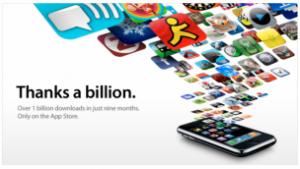We have been following recent developments in the mobile space for some time. Since Apple decided to enter the mobile space with the iPhone one could say that the industry has suffered a serious face-lifting, not only due to the iPhone per se (we could spend hours discussing if it’s a neat phone or not, if it’s useful to business customers or not, etc.), but fact is that in the past two years the mobile phone business has changed tremendously. And part of the trigger has been Apple’s proposition of focusing again on what the customer wants when he/she thinks about data: it’s all about the Internet. Which implies a lot of things -from a user-friendly multi-touch screen through the possibility of seeing the vast majority of Internet pages to the possibility of targeting content to the needs of the mobile phone user. This is why in this post we want focus what may be the “killer” to get the mobile Internet going: the existence of a good application ecosystem.
When Apple launched the iPhone three years ago, it already emphasized the fact that it was a device that would allow everybody to enjoy the full Internet experience – this was actually nicely taken up by the series of commercials that they run at that time.
A year later, in summer 2008, Apple launched not only its 3G phone, but also a new version of iTunes, which included a for some people long-awaited application store. Since then, the store has carried more than 35.000 application and reached 1 billion downloads just 9 months later (see also Fortune‘s post for more information about this).
I the past months we’ve seen that Google, Nokia, RIM, Miscrosoft all have followed Apple’s approach of announcing the launch of application stores or “marketplaces”. Google was the first to follow, launching its application store Android Market for applications to be run on the Android operating system. Google’s approach differs from Apple’s as it does not require any formal approval process (which has led to several complaints of iPhone application developers, since they claim that very often Apple takes up to several weeks to react). The Android store publishes any application, but as of today when you visit the store you still cannot find too many applications, although supposedly the developer community is becoming to get quite active. Reseach in Motion launched its Application World on April 1st, containing more than 100 applications for both business and entertainment. RIM emulates Apple’s approach of offering only applications for its own operating system, maintaining the control for publication of applications. This week, Nokia has followed a with the launch of its OVI store. The store carries all sort of applications for around 50 Nokia phones (of around 300Nokia models), and actually pretends to be not only a store, but a central marketplace for all sort of services and products, including music, ringtones, etc. In this sense, Nokia moves away from just being a handset producers to develop a beach head in the broader content and service world. Having said this, the formal launch has been a disaster, although one should expect that the problems that users have reported this week will be resolved soon. Similarly to Apple and RIM, Nokia also controls the publication of applications, but it has introduced an interesting twist in the payment alternatives, since it offers carrier billing (e.g, you pay through your phone bill) for a number of countries. We will have to analyze what this implies for the telecom operators in a future post.
Finally, Microsoft has repeatedly announced its launch of a Mobile Marketplace (initially known under the codename SkyMarket), but up until today the software giant still in mainly focussing on a marketplace for developers (a Windows Mobile Catalog) (an area that is very natural to it, since they have been nurturing their developers for the past 15 years or so), while the frontstore is still missing. Is this a sign of weakness, or is something big to come?
By the way, next we the traditional yearly Telecom Industry meeting takes place in IESE Madrid, and we will be able to listen to what the protagonists of this post have to say (with Nokia, Microsoft, and application developer and the operators debating about where the mobile Industry is going). You may want to check in, or get the conclusions of the meeting to read more about what’s going on.
PD. We haven’t focused on the role of operators in this post, simply because most of them are moving very timidly in this vein. France Telcom has launched a store, South Korea Telecom has announced one, but there is not much more to write, with the exception of O2’s Litmus store, which want to become a place where developers and final users interact, so giving it a nice web 2.0 twist. Have a look for yourself!



By the way, next we the traditional yearly Telecom Industry meeting takes place in IESE Madrid, and we will be able to listen to what the protagonists of this post have to say (with Nokia, Microsoft, and application developer and the operators debating about where the mobile Industry is going).
A year later, in summer 2008, Apple launched not only its 3G phone, but also a new version of iTunes, which included a for some people long-awaited application store.
Hi there,
Where could we check in the Telecom Industry meeting?
Regards,
Javier